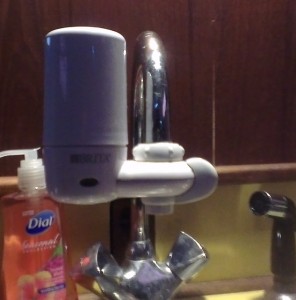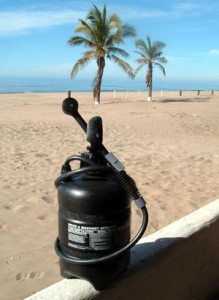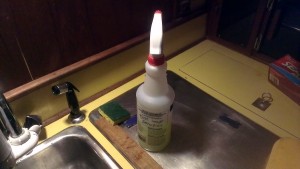I’m in serious research mode right now for this winter’s refit of my new (to me) 1982 Bayfield 29. What follows is a kind of crazy mind dump (meaning likely a bit incoherent and free flowing) detailing my thought processes for ground tackle.
There is a tremendous amount of noise out there regarding ground tackle (anchors, rode, and associated links), with lots of conflicting opinions, and web forum ugliness that I normally associate with political and religious discussions. Add in the complication of boats having different shapes, displacements, and windage profiles, the wide variety of bottoms that vary by geographic region, the expected weather one might encounter along one’s route, and the difference in how people actually use their boats, and you come up with a mess of confusion. Just for fun add in all the propaganda from the numerous anchor manufacturers and distributors (all of which seem to claim to be the “best”) and their varied methods of determining an appropriate size anchor (not to mention chain size and length), and it’s enough to cause a guy to bang his head against the wall.
Starting with my personal experience, I will say that I’m not entirely happy with the anchor system on my Bayfield at the moment. Currently she has a Danforth (genuine) 13S (13 lbs) on the bow, with an inadequate rode of maybe 10 feet of 3/8” chain and probably 80 feet of I think 5/8” 3-strand line. The anchor hangs from brackets on the pulpit, which I (and my back) find awkward to deal with. This system is probably adequate for occasional use in the Chesapeake; but I anchor out a lot (when away from my home marina I have yet to take a transient slip, and only rarely pick up a mooring) and plan on eventually going much further afield. I’ve only once had a difficult time setting this anchor in a crowded anchorage in the Rhode River near Annapolis. Although once it set it was fine, even with winds blowing into the 20s from different directions, I was unhappy with the five or six attempts to get it to set. Looking at this system…
Existing Ground Tackle System:
- The Danforth 13S appears to have 920 lbs of holding power.
- 3/8” Proof coil G3 chain has a Working Load Limit of 2,650 lbs.
- 5/8” three strand line (I’m using Samson Pro-Set as a reference, as I’m not sure what the actual manufacturer is) has an Average Tensile Strength of 10,000 lbs.
Sailboat Specs:
According to http://sailboatdata.com, the specs for the Bayfield 29 are…
- LOA: 29.00’/8.84m (this includes the bowsprit…the LOD is probably a little more than 27′)
- LWL: 21.75’/3.10m Beam: 10.17’/3.10m Draft: 3.50’/1.07m Displacement: 7100 lbs/3221 kgs. (I’m told that virtually all B29s are heavier than this…I’m going to run with 10,000 lbs as a cruising displacement until I learn otherwise).
- Ballast: 3000 lbs/1361 kgs
- Hull Type: Long Keel
- Rig Type: Cutter
I replicated some info, I believe originally sourced from the ABYC, in
the chart below…
| Ground Tackle Design Loads |
| Length Over All (Feet) |
Boat Beam (Feet) |
Load on Tackle and Hardware (pounds) |
| Sail |
Power |
15 Knots |
30 Knots |
42 Knots |
60 Knots |
| 10 |
4 |
5 |
40 |
160 |
320 |
640 |
| 15 |
5 |
6 |
60 |
250 |
500 |
1,000 |
| 20 |
7 |
8 |
90 |
360 |
720 |
1,440 |
| 25 |
8 |
9 |
125 |
490 |
980 |
1,960 |
| 30 |
9 |
11 |
175 |
700 |
1,400 |
2,800 |
| 35 |
10 |
13 |
225 |
900 |
1,800 |
3,600 |
| 40 |
11 |
14 |
300 |
1,200 |
2,400 |
4,800 |
| 50 |
13 |
16 |
400 |
1,600 |
3,200 |
6,400 |
| 60 |
15 |
18 |
500 |
2,000 |
4,000 |
8,000 |
The Bayfield’s beam is a little wider than 9′; but she is a little shorter than 30′, so I’m going to work on the assumption that this is close enough. According to this info the Danforth 13S should be quite satisfactory as a working anchor in winds up to 30 knots. I have a second identical system below deck if it looks like I’ll be anchoring in more than that (and I have). Frankly, I’d prefer to have the primary hook at least handle the 42 knot load. I’d also like it to nest on a bow roller, and not hang from the pulpit (which is clumsy to handle). I’ll probably install a windlass at some point, too, which would also take advantage of a bow roller.
Digging through the manufacturer sites, I compared Danforth, Fortress, Rocna, and Manson Supreme anchors (these are the readily available anchors I’m personally most familiar with, having used all of them at one point or another). I wanted to compare the claw variants as well as I have one on my Seafarer 24 and like it a lot, but had trouble finding info I could use for a paper comparison. I took a guess and included one anyhow as the price is very competitive. The Fortress and Danforth listed Holding Power while the Rocna claims that their recommended anchor is good to 50 knots and I worked under the assumption that the very similar looking Manson Supreme would have similar working limits (they claim they are better than the Rocna; but then Rocna claims they are better than the Supreme!). I was surprised to find that Rocna no longer carries the huge premium price they had in years past, and are now actually a little cheaper than the most equivalent Manson Supreme, possibly due to the substandard (or at least, sub-speced) steel quality that occurred after moving manufacturing to China (a problem that is supposed to have been corrected, I understand).
| Anchor comparison |
| Brand |
Model |
Weight |
Holding Power |
Defender Price (10/8/12) |
Notes |
| Danforth |
13S |
13 |
920 |
|
Existing Anchor |
| Danforth |
12H |
12 |
1,800 |
$147.19 |
|
| Danforth |
20H |
20 |
2,500 |
$206.99 |
|
| Danforth |
35H |
35 |
3,800 |
$331.19 |
|
| Fortress |
FX-16 |
10 |
1,250 |
$197.79 |
|
| Fortress |
FX-23 |
15 |
2,000 |
$308.19 |
|
| Fortress |
FX-37 |
21 |
3,000 |
$427.79 |
|
| Rocna |
10 |
22 |
|
$227.23 |
Good to 50kts |
| Rocna |
15 |
33 |
|
$275.99 |
Storm Size |
| Manson |
Supreme 25 |
25 |
|
$239.00 |
Good to 50kts |
| Manson |
Supreme 35 |
35 |
|
$326.59 |
Storm Size |
| Lewmar |
Horizon Claw |
22 |
|
$40.00 |
Manu. Recommended size. |
| Lewmar |
Horizon Claw |
33 |
|
$142.00 |
Working size? |
While it looks like we are comparing apples to apples, because of the lack of measuring standards we appear to actually be comparing apples to kiwi fruit or something. While Danforth and Fortress provided holding power numbers (I have no idea how they came up with them, and if the method they used is standardized), no one else felt the need, so I need to make some educated assumptions. It’s also worth noting that holding power alone does not an anchor make, and that each performs differently in different bottoms, and each may handle a change in the direction of pull differently, which is why many people recommend keeping multiple anchor types aboard.
Let’s use the 42 knots on the original chart as our target need for a primary anchor. This would be more than a weekender would need; but when I transition to full time cruising it seems like a reasonable number to work with. I will use the 60 knot range as the target storm anchor size, making the assumption that one size up would be appropriate where holding power is not listed. It is worth noting that the “H” versions (High Tensile) of the Danforth anchor have significant increases in holding power over the “S” (standard) version that currently exists on the boat.
So, our working anchor choices are now:
| Working Anchor Comparison |
| Brand |
Model |
Weight |
Holding Power |
Defender Price (10/8/12) |
Notes |
| Danforth |
12H |
12 |
1,800 |
$147.19 |
|
| Fortress |
FX-23 |
15 |
2,000 |
$308.19 |
|
| Rocna |
10 |
22 |
|
$227.23 |
Good to 50kts |
| Manson |
Supreme 25 |
25 |
|
$239.00 |
Good to 50kts |
| Lewmar |
Horizon Claw |
33 |
|
$142.00 |
Working size? |
And our storm anchor choices are:
| Storm Anchor Comparison |
| Danforth |
35H |
35 |
3,800 |
$331.19 |
|
| Fortress |
FX-37 |
21 |
3,000 |
$427.79 |
|
| Rocna |
15 |
33 |
|
$275.99 |
Storm Size |
| Manson |
Supreme 35 |
35 |
|
$326.59 |
Storm Size |
Surprisingly, on the storm anchor chart the Danforth is more expensive than both Rocna and Manson, so given my so-so feelings towards that anchor, and the issue it sometimes has resetting when the boat swings, I’m going to cross it off the Storm list. Since I already have a couple 13S anchors, I’m going to cross it off the Working list as well.
I don’t think I have room to store a Rocna or Manson Supreme anyplace but on the bow of the boat (they are bulky), so they are not really suitable for keeping below in reserve for the rare storm, and a very expensive Fortress which can be disassembled for storage might fit that bill better. The affordable claw, using my best guesses as to equivalent weight, gets kind of heavy in comparison to the others for the Working Anchor size. It does suggest, however, that if 33 lbs is OK for a working anchor, then I might just as well hang a Rocna 15 (33 lbs, $275.99) off the bow to cover me through pretty much any situation I’m likely to find myself in. Peter Smith (the designer of the Rocna and former scourge of internet forums everywhere) is adamant in his claims that the sizing recommendations for the Rocna are conservative (the recommended size is the 22 pounder, theoretically good to 50 knots) and that it really shouldn’t be necessary to go larger, although I worry about having to ride out a hurricane at anchor someday.
I think I need to stop at West Marine and actually see how big this gear is. Perhaps combining a Rocna 10 on the starboard side of the bowsprit, with a Lewmar Horizon Claw 22 (the manufacturer recommended size) on the port side would be a good compromise allowing multiple anchor situations (tight swing room or storm use) and a spare setup in case of primary anchor failure (either through loss or simply not being able to set properly). A seven pound Fortress FX-11 ($142.59) as a stern/kedge anchor would round out the set nicely, especially since I think I already have one (although what I have might be an FX-7). And what the heck, if I can find the room I can always keep one of the Danforth 13Ss around for good measure.
Feed from: http://continuousmoon.blogspot.com/
 Naturally, some water shouldn’t be conserved. It is important to drink plenty of water, especially in the warmer months. Many people do their drinking solely from disposable plastic water bottles, which is a great way of consuming good tasting, clean water. It’s also expensive and wasteful. Admittedly, I do do this; but I am trying to break myself of the habit. I have installed on the pressure water system a Brita filter which produces fine tasting water from my 30+ year old water tanks.
Naturally, some water shouldn’t be conserved. It is important to drink plenty of water, especially in the warmer months. Many people do their drinking solely from disposable plastic water bottles, which is a great way of consuming good tasting, clean water. It’s also expensive and wasteful. Admittedly, I do do this; but I am trying to break myself of the habit. I have installed on the pressure water system a Brita filter which produces fine tasting water from my 30+ year old water tanks. Other daily water uses can easily be reduced. Baby wipes are inexpensive, and wonderful for a daily sponge bath. They aren’t as nice as a real shower, of course; but they do greatly reduce the need of the daily shower dirt dwellers are accustomed to.
Other daily water uses can easily be reduced. Baby wipes are inexpensive, and wonderful for a daily sponge bath. They aren’t as nice as a real shower, of course; but they do greatly reduce the need of the daily shower dirt dwellers are accustomed to.
